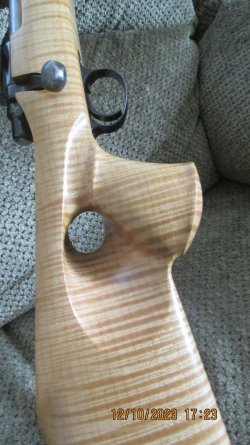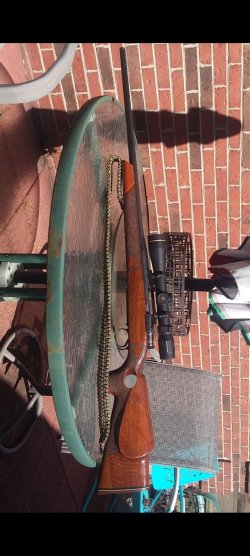-
If you are being asked to change your password, and unsure how to do it, follow these instructions. Click here
You are using an out of date browser. It may not display this or other websites correctly.
You should upgrade or use an alternative browser.
You should upgrade or use an alternative browser.
Any Stock Finishers here ? I have a couple questions
- Thread starter CjC73
- Start date
 Help Support Long Range Hunting Forum
Help Support Long Range Hunting Forum
That looks sharp, the rosewood stands out against the walnut. I don't do stocks I do furniture. So I look at big slabs of wood. If I lived where you are Goby walnut would be somewhere I could shop, but living in Florida the freight will kill meCheck out the reasonable Richards prices for select Bastogne. A Richards select Bastogne - .20P Rodent Rifle. Note the excellent grain flow thru grip.
View attachment 519817
Hugnot
Well-Known Member
Here is an example of maple fiddleback - would also work real good for fine tones from violin. They applied secret formula shellac stuff for violins.Hi CJ,
What you are seeing are the different denisities of the wood. The Fiddleback or Flame is created where the tree was stressed by wind and as the tree flexed back and forth sections of the grain were compacted and flexed over an over again. This creates ribbons of higher density cellulose and hence the pattern. As you apply the finish, the less dense areas soak up the oil more readily than the higher density areas. Be sure not to apply too much finish as you will create a thick layer that becomes gummy and does not dry effectively. Be sure to take is slow and rub in between coats with a bit of hand pressure to removing excess. Let it soak in overnight and then apply another coat. Taking it slow and rubbing it in will ensure your finish becomes uniform and dense without tackiness over time. As you build layers, the different soak rates will stop and it will become one uniform finish.


This is wifey's .22-.250 , 7.7 fast twist for 75 ELDM bullets - low recoil. Cherry wood fore-end, contrasty. Finished quick easy with 6 coats of Poly. Rub. I have always marveled at violin construction & workmanship. The flash sort of made the first pic look yellowish. Poly Rub resists turning yellow.
Last edited:
You need to fill the pores. I like to use super fine sand paper and true oil. I can't remember if I did 400 or 600 grit with true oil. Apply the oil by hand messaging it in well applying enough to keep a slightly moist look all over the stock. Once you have it all over the stock use the sandpaper on the wet oil and "sand" the oil along the grain. You will see the oil and wood dust start to make a different color and a paste of sorts. Sanding the oil/ paste mixture presses the mixture deep into the pores. Let dry for 24-48 hrs. I do this several times until it has a glass like appearance. The last coat I don't sand it in, once that coat is dry I buff with compound and a fine clean new rag.
@Hugnot .... I love that maple fiddleback. So you just sanded it and applied straight polyurethane?
I've sanded with the oil to try and fill the pores. Never seemed to fill them in.
Does tru oil fil pores with like 4-6 coats?
I've been working on removing the oil in already put on by sanding with 320 and using light heat from a heat gun to bring the oil to the surface and wiping it with acetone.
I've sanded with the oil to try and fill the pores. Never seemed to fill them in.
Does tru oil fil pores with like 4-6 coats?
I've been working on removing the oil in already put on by sanding with 320 and using light heat from a heat gun to bring the oil to the surface and wiping it with acetone.
Allen Lone wolf
Well-Known Member
I to have used minwax satin wipe on poly. It does a good job also and quicker than tung oil for sure.I've refinished several stocks over the last ten or so years. A couple things I do, one is use 3M sanding pads instead of steel wool, some steel wools have oil on them, some don't. For the finish I really Minwax satin Wipe On Poly, easy to apply and provides a nice low sheen, yet still highlights the grain.
Hugnot
Well-Known Member
Not straight polyurethane - I used Min Wax Poly Rub - this stuff will fill big pore claro walnut other similar woods. The deal is to apply a real generous coat, really slather it on, and wait up to 10-12 hours at normal room temps & humidity for it to dry the point where sanding produces white dust. Sand it down well then more Poly Rub but drying time will be greatly reduced after first coat, like 4-5 hours. After 3-5 cycles pores should be filled. Maple fills much faster.@Hugnot .... I love that maple fiddleback. So you just sanded it and applied straight polyurethane?
I've sanded with the oil to try and fill the pores. Never seemed to fill them in.
Does tru oil fil pores with like 4-6 coats?
I've been working on removing the oil in already put on by sanding with 320 and using light heat from a heat gun to bring the oil to the surface and wiping it with acetone.
Poly Rub contains some sort of drier(s) that speed up drying times but very first coat takes up to 1/2 day.
Be real careful with acetone - I have some real bad stories on that stuff but not in the context of stock finishing. If I have any acetone it does not share living spaces - keep it in back yard shed - probably irrational fear.
My guess on your situation the finish has not dried or cured entirely. Sand it well with 320 after keeping stock in warm room for 3-4 days.
Allen Lone wolf
Well-Known Member
Look for local hardwood dealers and Craigslist fiddleback maple and curly maple are the same fiddleback is typically quarter sawn and curly is flat sawn. Also look for quilted maple@Hugnot Not straight polyurethane - I used Min Wax Poly Rub - this stuff will fill big pore claro walnut other similar woods.
MinWax Wipe-On Poly?
I've used that as well
Where did you get the maple fiddleback stock? I'd love a stock with that type of wood.
@Hugnot .... I love that maple fiddleback. So you just sanded it and applied straight polyurethane?
I've sanded with the oil to try and fill the pores. Never seemed to fill them in.
Does tru oil fil pores with like 4-6 coats?
I've been working on removing the oil in already put on by sanding with 320 and using light heat from a heat gun to bring the oil to the surface and wiping it with aceto
For me, pores in my walnut stock sealed up after about 8 coats of Tru Oil. For the first coat, I made walnut sawdust (powder) with a disc sander and rubbed a little bit of that in while applying the Tru Oil, but it still took many coats to finally seal the pores. I don't know the product you are using, but Tru Oil hardens to the touch in a few hours. There is no oily residue, it's like polyurethane but goes on in thinner coats. I would experiment on a scrap piece of wood until you have a system worked out that you are comfortable with and get good results. Regarding the beautiful maple stock discussed, maple has closed pores so a nice finish can be achieved with fewer coats.@Hugnot .... I love that maple fiddleback. So you just sanded it and applied straight polyurethane?
I've sanded with the oil to try and fill the pores. Never seemed to fill them in.
Does tru oil fil pores with like 4-6 coats?
I've been working on removing the oil in already put on by sanding with 320 and using light heat from a heat gun to bring the oil to the surface and wiping it with acetone.
Probably should use bronze wool. Steel wool will supposedly get imbedded in the wood and turn black/red when it rusts.You will need to use Steel wool on that to get a fine finish start with coarse wool then fine to et the desired texture, you may have to finish up with the 0000 fine wool sand paper is only for shaping not finishing wood
Thank you one and all for the posts on this topic! I have been avoiding finishing a beautiful fiddleback maple stock for a custin blackpowder rifle for decades as I simply really had never discussed with expert(s). I now have a game plan and should be able to do this over these chilly and drerary days in East TN this winter.
A lot of muzzleloader stocks have aqua fortis (iron acetate) on them before the final finish. It's used to make the curl and fiddle back in maple pop.Thank you one and all for the posts on this topic! I have been avoiding finishing a beautiful fiddleback maple stock for a custin blackpowder rifle for decades as I simply really had never discussed with expert(s). I now have a game plan and should be able to do this over these chilly and drerary days in East TN this winter.
I'd do some research before putting sandpaper to my stock. I bult a new .40 muzzleloader two years ago and used a ferric nitrate solution instead of ferric acetate. Ferric acetate is some nasty stuff.
My stock doesn't have much figure, but the wood I made accessories out of did have.
Last edited:

